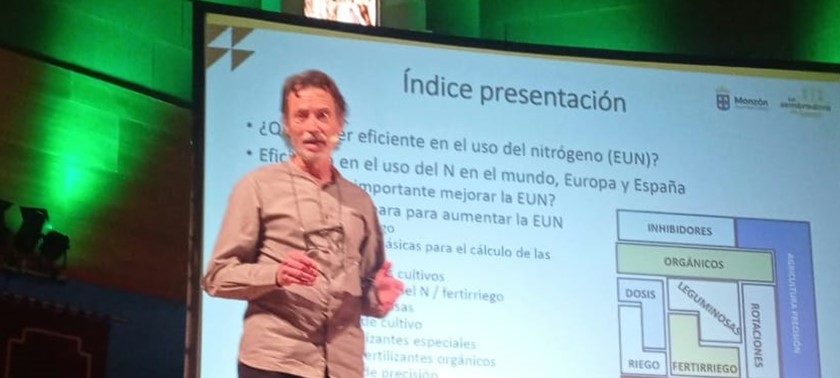After its third edition, the annual event “La sembradora de Ideas”, organized by the Monzón City Council, is consolidated as an essential event on the evolution of the primary sector. In the 2023 edition, the chosen theme was “Step by step: fertilizing and digitizing farms.” The event featured an opening presentation by Ramón Isla, a CITA researcher.
Food production faces a formidable challenge in the coming years. On the one hand, the world population is expected to continue growing to more than 9,000 million inhabitants by 2050, which implies the need to increase crop production considerably, at least with the current food consumption habits in developed countries. This greater production, in many countries, cannot be attained through an increase in the cultivated area, due on the one hand to the lack of fertile soils and on the other hand to the need to maintain uncultivated areas (forests, meadows, areas of riverbank, etc.) that perform vital functions for the functioning of the planet (carbon storage, water retention and purification, soil retention) and to maintain the habitat of the rest of the planet’s species.
Nitrogen is essential for agricultural production and was the most limiting element of crops before the discovery of the Haber Bosch reaction in 1910, which allowed ammonia to be produced from abundant atmospheric nitrogen. The German chemist Fritz Haber received the Nobel Prize in Chemistry in 1918 for this discovery, which indicates the impact that this advance had. From then on, the production of nitrogen fertilizers allowed crop production to increase exponentially. However, in the last 50 years its extensive use has led to an alteration of the nitrogen cycle at a planetary level, causing, among other problems, processes of contamination of surface and groundwater, negative effects on the diversity in ecosystems and an increase in emissions of nitrous oxide, a powerful greenhouse gas that contributes to global warming.
These facts make it necessary to increase efforts to improve the efficiency with which agricultural systems use the N that is applied, which in agronomic terms is defined as Nitrogen Use Efficiency. Some works estimate that approximately, at a global level, 47% of the N added to crops is converted into N in harvested products. This implies that a considerable part of the N that is applied is not used and ends up being lost through different routes of the agrosystems. The objective is to maximize efficiency, but also to maintain high production levels that allow farmers’ economic activity to be viable and increase food production. The intense increase in the livestock herd in the Ebro Valley in recent decades has increased the magnitude of the challenge, given the large amount of manure and slurry generated.
Ramón Isla’s presentation dealt with these concepts about the use of nitrogen in agriculture, as well as strategies to optimize the efficiency of nitrogen use. Among them, the optimization of the dose of inorganic and organic nitrogen fertilizers, the fractional application of these fertilizers, the use of slow release fertilizers, the adjustment of irrigation to crop water requirements to minimize nitrate losses through percolation, or crop rotations including legumes. In recent years, advances in precision agriculture point to the use of new technologies that now allow adjusting the doses of N in the different areas of the plot depending on the needs and/or the available N.
The presentation can be consulted and downloaded here:
Link to the 2023 Event of “La Sembradora de Ideas”:

